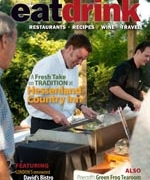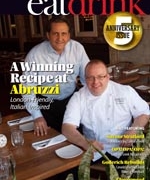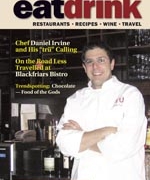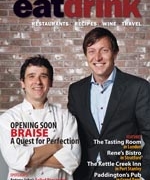The Taste of Place
The pleasures of identifying unique flavours in food based on where it comes from is something that started in France with regional wine. The French call it terroir, meaning the taste of place adds something unique to certain foods. Even though the idea was conceived in France, it is spreading as a culinary concept as Rowan Jacobsen elaborates on in American Terroir: Savoring the Flavors of Our Woods, Waters, and Fields, taking us through some of the North American regions that give unique terroir to foods around us. He writes: “If you want to tour the museum of old terroir masterpieces, go to France and Italy. If you want to visit the galleries where new artists are trying new things, look around America.” From the southernmost tip of the Central American country of Panama to the northern reaches of the Yukon River in Alaska, this book covers an entire continent. Maple syrup, coffee, apples, honey, potatoes, mushrooms, oysters, avocados, salmon, wine, cheese, and chocolate take on elevated stature as High-Mountain Maple Syrup of Vermont or Totten Inlet Oysters of Puget Sound becoming “great foods that are what they are because of where they come from.”
Terroir can be attributed to the microclimate where a type of food grows, most notably the soil with high mineral content, but also water, air, temperature, rock formations, altitude, and wind. The easiest proof that terroir is the real deal is to realize that the same seeds grown in different soil will taste very different. The red-tinted soil of P.E.I. not only provides ideal conditions for potatoes to grow, but also bleeds into the Pacific Ocean which encourages algae growth to nourish mussels along the shore. Terroir in the world of coffee relies heavily on altitude – the higher the coffee bean trees grow, the better quality coffee will result. Based on accolades for outstanding taste, as well as a record-breaking price of $130 per pound at a 2007 auction, the best coffee on the market is Esmeralda Special, grown at altitudes nearing 5,000 feet from the Hacienda la Esmeralda estate in Panama. For the vast varieties of terroir in honey which take on different floral notes based on geography, we can thank the bees that collect nectar from thousands of flowers within a three-mile radius of their hive. Even volcanoes have contributed to the taste of apples in Washington; when Mount St. Helens erupted in 1980 covering Yakima Valley in ash, it acted as super fertilizer and created the best crop ever for Harmony Orchard, which grows the world’s top organic apple varieties.
The elements may govern terroir, but the human response to the natural processes around them and a partnership with the landscape allow it to work – sugarbush owners tap sap from trees and beekeepers draw honey from the bees’ hives. “At the core, our interest in terroir is an enduring desire to partner with a landscape, survive on it, and live well.” The most memorable human in Jacobsen’s quest to seek out terroir was a foraging expedition with a true woodsman, Francois Brouillard, who practices forest gastronomy in Quebec. Even though the modern age has allowed most people to outsource the need to grow or forage our own food, Brouillard is an example of someone still living completely from the tracts of land around him and offering only those foods in his restaurant, Les Jardins Sauvages, for special weekend tastings. After a few days with Brouillard, the author realizes “how narrow the modern palate has become. The handful of plants that comprise most American diets have not been chosen because they are particularly compelling, but because they are convenient.”
“Oysters are one of the only foods that, like European wines, are named for the place they come from. Whether from coastal towns like Bluepoint and Wellfleet, or bays like Apalachicola and Malpeque, oysters have always been identified by their home waters, because they taste like those waters.” Jacobsen finds himself tromping through exposed ocean floor of Puget Sound at three in the morning, when the tide is lowest, to eat oysters fresh out of their habitat.
Most of us think of organic as being pesticide and chemical free, but that doesn’t mean pest free all the time. Jacobsen found out on avocado farms in Michoacan, Mexico and apple orchards in Yakima Valley, Washington that some natural pests are welcome and respected for their role in the ecology. In avocado farming, “the fruit with pest damage actually has more flavour than the perfect fruit. Many flavour compounds are chemicals produced by plants to ward off pests.” Natural chemicals exist in fruit growth to fight off pests and enhance taste at the same time.
Jacobsen also gives us new ways to think about food: “Once you start using avocado in place of butter and cream, you realize why the Mesoamerican cultures had no need for dairy. In everything from creamy soups to decadent desserts, avocados work like butter and can be grown using a fraction of the resources needed for dairying.” Not to mention sipping flights of maple syrup, like wine or liquor, to taste the nuances, or his recipe suggestion of wild mushroom cookies.
The two words in the translation are “taste” and “place,” but there is an economic side to terroir as well. “For terroir to be more than a whim, it has to answer the question, What does this landscape do best? And the market must be knowledgeable enough to support that, to be willing to pay enough for superior foods to keep the producers in business.” Vermont cheese makers have land excellent for sustaining cows, so they focus on cheese made from cows’ milk, and not goats or sheep, which take on their own superiority in other regions. An interesting twist that Jacobsen uncovered in his investigation of cheeses in Vermont is that terroir in France is in decline just as American terroir is on the rise. As Americans turn to more sustainable and artisan methods of producing food, the younger French generation is being seduced by supermarket chains.
The best examples of terroir around here are in the summer when most of us can probably say we have a favourite roadside corn stand that tastes better than all the other corn on the cob, or some Leamington area tomato growers that have the sweetest, juiciest tomatoes all from being lucky with the nutrient-rich soil on their farms. There is a certain pride to the close-to-home philosophy of terroir and it is most successful when citizens support local varieties, but when you find yourself traveling, Jacobsen’s book acts as a very readable reference to the map of flavours offered in regional locations across North America.










